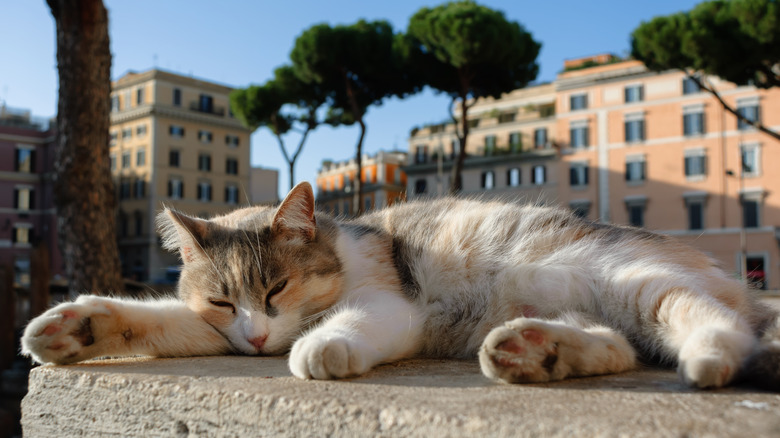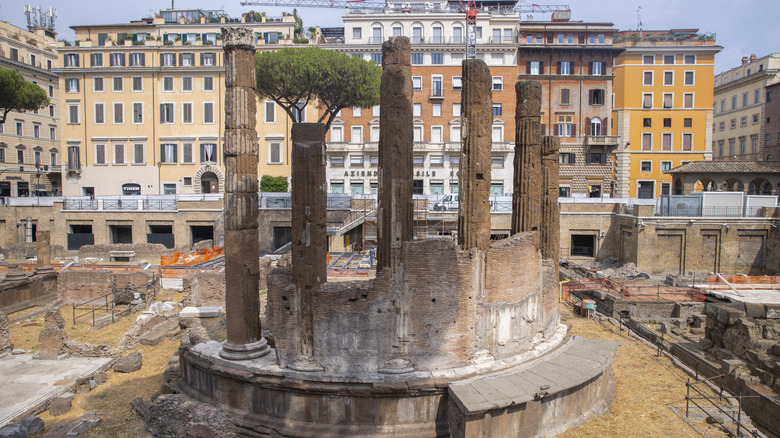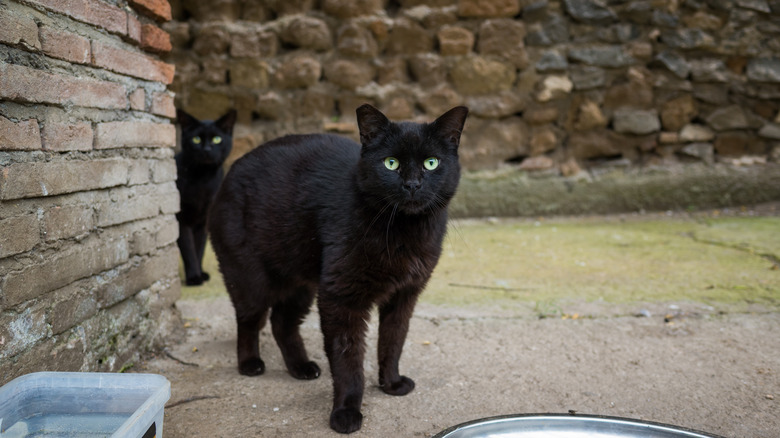Discover Italy's Most Famous Cat Sanctuary At A Gorgeous Ancient Site In Downtown Rome
If you've visited Rome on an Italian vacation, you may have walked by an area that sits about 20 feet below street level, full of the ruins of temples. You weren't permitted to enter until recently, but from the street, you could see plenty of cats. Some sit on pillars, some are sprawled in the sun, and others are simply relaxing where a world-changing event took place. This is the Torre Argentina, the archaeological park where Julius Caesar was stabbed at the Curia of Pompey on March 15, 44 B.C.E. It was buried over the years, but rediscovered in the 1920s when dictator Benito Mussolini had many old buildings torn down. Inside the area, you'll see the ruins of four temples, as well as a bit of the infamous Curia of Pompey. (If you thought Caesar was killed in the Forum, you're not alone. However, his cremated remains were buried there.) The murder of Julius Caesar ushered in a new era of Emperors and Roman expansion all over the world. It's a pretty significant place that also happens to be full of fuzzy felines.
Though visitors weren't allowed to go down into the Torre Argentina until 2023, they could enter one area, which is the cat sanctuary. Volunteers continue to take care of them, spaying and neutering them, and treating illnesses and injuries. You can even symbolically adopt a kitty by giving a regular gift of money to support the sanctuary. Cats and history? Sign us up!
All about the Torre Argentina in Rome
The Torre Argentina sits at the corner of the Via Florida and the Via di Torre Argentina, a walk of 0.3 miles from the Pantheon (a must-see experience in Rome), or 0.6 miles from the Trevi Fountain, which you'll likely be visiting anyway. The name "Torre Argentina" doesn't refer to the country, but a tower called Argentoratum that is no longer there. When the old buildings were taken down, workers found part of a statue, leading to an excavation. What they uncovered were four temples (designated A, B, C, and D) from the fourth to the second centuries B.C.E. Temple C, likely dedicated to a fertility goddess, is the oldest, with D dedicated to either Lares Permarini or maybe the nymphs, with B (above) possibly dedicated to Fortuna Huiusce Diei, or the Fortune of the Present Day. A is likely dedicated to Juturna, a goddess of wells, springs, and fountains. You'll also see the base of the Curia of Pompey, the site of the stabbing. (After it happened, Caesar's adopted nephew, Augustus declared this a cursed place.)
In 2023, it opened up to visitors for the first time after renovations partially funded by a million-dollar donation from the Italian fashion house Bulgari. You must have a pre-purchased ticket, which you can get here. They're around $5.50 for adult non-residents and $4.50 for adult residents, with several other ticket tiers. (No food and drink are allowed and there are no bathrooms.)
There is a walkway route so you can see things close up, as well as two exhibitions that show items found during excavations. This site is accessible for those with mobility issues and in wheelchairs, with a lift and evened-out foundation. It's also accessible for the visually impaired through tactile panels and 3D scans of items.
The adorable cats of Torre Argentina
The cats of the Torre Argentina were taken care of by volunteers, or "gattare" meaning "cat ladies," beginning back in 1929 when the excavations first happened. These were stray or abandoned cats, and they've been cared for through the years by many, including Italian star Anna Magnani when she worked nearby. In 1993, two women named Lia and Silvia joined another who had been taking care of the kitties by herself and was having a hard time keeping up with expenses. They started the Torre Argentina Cat Sanctuary. Taylor Swift would be proud.
They took over a sheltered spot near Temple D that was in rough shape until they began working with the A.I.S.P.A. (Anglo-Italian Society for the Protection of Animals). They've raised funds with the help of many people around the world, and continue to take care of the little fuzzy creatures, spaying and neutering them, feeding them, and giving them veterinary care.
If you want to help out, you can donate on their website. The place is completely dependent on donations. Another way you can help is to participate in their ADD program, aka "adopt at a distance." You pay a fee of around $16.60 (€ 15) per month or at other intervals, with the name of your chosen cat. You'll get updates and pictures every six months. You can even follow the sanctuary on Instagram to meet some of the cats. The sanctuary is open every day from 12:00 p.m. to 4:30 p.m.


